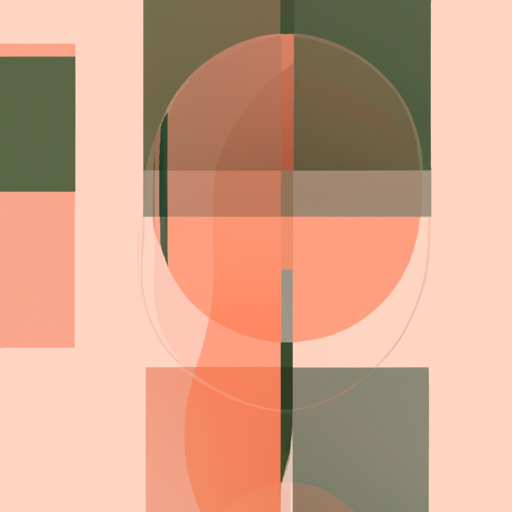
-
Table of Contents
Geometric Abstraction: Math and Art in Design

Art and mathematics may seem like two completely different disciplines, but they have a deep and intertwined relationship. One area where this connection is particularly evident is in geometric abstraction. Geometric abstraction is a style of art that uses geometric shapes, lines, and patterns to create visually appealing and thought-provoking compositions. In this article, we will explore the fascinating world of geometric abstraction, its roots in mathematics, and its impact on design.
The Origins of Geometric Abstraction
Geometric abstraction has its roots in ancient civilizations, where geometric patterns were used in architecture, pottery, and textiles. However, it wasn’t until the early 20th century that geometric abstraction emerged as a distinct art movement. Artists such as Kazimir Malevich, Piet Mondrian, and Wassily Kandinsky embraced geometric forms and lines as a way to break free from representational art and explore the pure essence of form and color.
One of the key influences on geometric abstraction was the development of non-Euclidean geometry in the 19th century. Non-Euclidean geometry challenged the traditional Euclidean geometry, which was based on the assumption of a flat, two-dimensional space. Non-Euclidean geometry introduced the concept of curved spaces, which opened up new possibilities for artists to explore in their work.
The Role of Mathematics in Geometric Abstraction
Mathematics plays a crucial role in geometric abstraction. Artists use mathematical principles and concepts to create harmonious compositions and explore the relationships between shapes, lines, and colors. One of the fundamental mathematical concepts used in geometric abstraction is symmetry.
Symmetry is the balance and harmony achieved by arranging elements in a way that creates a sense of equilibrium. Artists often use symmetrical compositions to create a sense of order and stability in their work. For example, the Swiss artist Paul Klee frequently used symmetrical patterns in his paintings to create a sense of balance and harmony.
Another mathematical concept used in geometric abstraction is the golden ratio. The golden ratio is a mathematical ratio that is often found in nature and has been used by artists and designers for centuries. It is believed to create aesthetically pleasing compositions. Artists often use the golden ratio to determine the proportions and placement of elements in their work.
Examples of Geometric Abstraction in Design
Geometric abstraction has had a significant impact on design across various disciplines, including architecture, graphic design, and product design. Let’s explore some examples of how geometric abstraction is used in these fields:
Architecture
Geometric abstraction has been a source of inspiration for architects throughout history. One notable example is the Bauhaus movement, which emerged in Germany in the early 20th century. Bauhaus architects, such as Walter Gropius and Ludwig Mies van der Rohe, embraced geometric forms and clean lines in their designs. The Bauhaus school building itself, designed by Gropius, is a prime example of geometric abstraction in architecture.
Graphic Design
Geometric abstraction has also had a significant impact on graphic design. Many designers use geometric shapes and patterns to create visually appealing and memorable designs. One famous example is the logo of the multinational technology company Apple. The logo, a simple apple shape with a bite taken out of it, is a perfect example of how geometric abstraction can create a recognizable and iconic design.
Product Design
Geometric abstraction has also influenced product design. Many products, from furniture to household items, feature geometric shapes and clean lines. The famous Barcelona chair, designed by Ludwig Mies van der Rohe, is a classic example of geometric abstraction in product design. The chair’s clean lines and geometric form make it a timeless and elegant piece of furniture.
The Impact of Geometric Abstraction on Design
Geometric abstraction has had a profound impact on design. Its emphasis on clean lines, geometric forms, and harmonious compositions has influenced countless designers and artists. Here are some key ways in which geometric abstraction has shaped design:
- Minimalism: Geometric abstraction often embraces minimalism, focusing on essential elements and eliminating unnecessary details. This minimalist approach has influenced various design disciplines, from architecture to fashion.
- Visual Hierarchy: Geometric abstraction helps designers create a clear visual hierarchy by using different shapes, sizes, and colors. This hierarchy guides the viewer’s attention and helps communicate information effectively.
- Order and Structure: Geometric abstraction brings order and structure to design. By using geometric shapes and patterns, designers can create a sense of balance and harmony in their work.
- Timelessness: Geometric abstraction has a timeless quality that transcends trends and fads. Its emphasis on fundamental forms and principles ensures that designs remain relevant and visually appealing for years to come.
Conclusion
Geometric abstraction is a fascinating art movement that combines mathematics and art to create visually appealing and thought-provoking compositions. Its roots in ancient civilizations and its development in the 20th century have had a profound impact on design across various disciplines. By embracing geometric forms, lines, and patterns, designers can create harmonious compositions that communicate effectively and stand the test of time. Whether in architecture, graphic design, or product design, geometric abstraction continues to inspire and shape the world of design.
